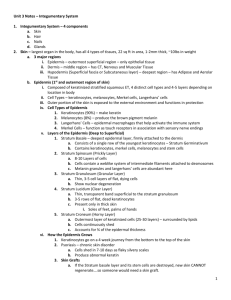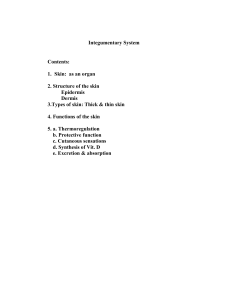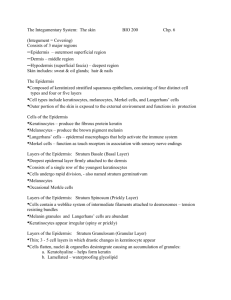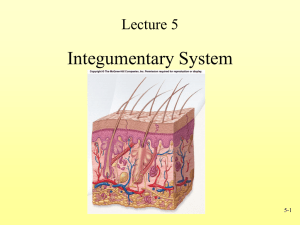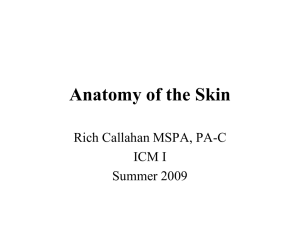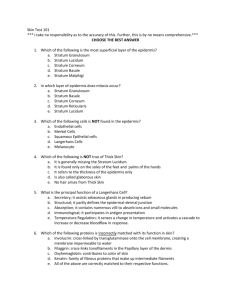Epidermis
advertisement
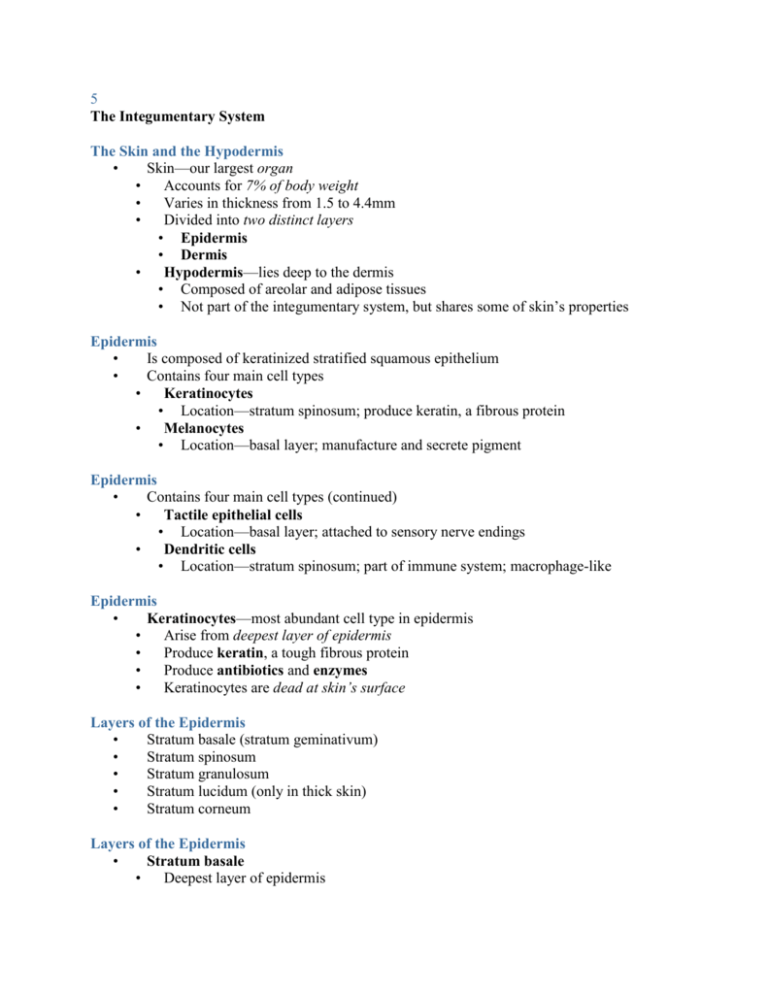
5 The Integumentary System The Skin and the Hypodermis • Skin—our largest organ • Accounts for 7% of body weight • Varies in thickness from 1.5 to 4.4mm • Divided into two distinct layers • Epidermis • Dermis • Hypodermis—lies deep to the dermis • Composed of areolar and adipose tissues • Not part of the integumentary system, but shares some of skin’s properties Epidermis • Is composed of keratinized stratified squamous epithelium • Contains four main cell types • Keratinocytes • Location—stratum spinosum; produce keratin, a fibrous protein • Melanocytes • Location—basal layer; manufacture and secrete pigment Epidermis • Contains four main cell types (continued) • Tactile epithelial cells • Location—basal layer; attached to sensory nerve endings • Dendritic cells • Location—stratum spinosum; part of immune system; macrophage-like Epidermis • Keratinocytes—most abundant cell type in epidermis • Arise from deepest layer of epidermis • Produce keratin, a tough fibrous protein • Produce antibiotics and enzymes • Keratinocytes are dead at skin’s surface Layers of the Epidermis • Stratum basale (stratum geminativum) • Stratum spinosum • Stratum granulosum • Stratum lucidum (only in thick skin) • Stratum corneum Layers of the Epidermis • Stratum basale • Deepest layer of epidermis • • • Attached to underlying dermis Cells actively divide Stratum basale contains • Tactile epithelial cells—associated with sensory nerve ending • Melanocytes—secrete the pigment melanin Layers of the Epidermis • Stratum spinosum (spiny layer) • “Spiny” appearance caused by artifacts of histological preparation • Contains thick bundles of intermediate filaments (tonofilaments) • Resist tension and contain the protein prekeratin • Among the keratinocytes are star-shaped dendritic cells • Are a type of macrophage • Function in immune system Layers of the Epidermis • Stratum granulosum • Consists of a few layers of keratinocytes • Keratinocytes contain • Keratohyaline granules—help form keratin • Lamellar granules—contain waterproofing glycolipid • Above stratum granulosum • Cells are too far from dermal capillaries to receive nourishment Layers of the Epidermis • Stratum lucidum (clear layer) • Occurs only in thick skin • Locations of thick skin—palms and soles • Composed of a few rows of flat, dead keratinocytes Layers of the Epidermis • Stratum corneum (horny layer) • Thick layer of dead keratinocytes and thickened plasma membranes • Protects skin against abrasion and penetration Dermis • • • • • • Second major region of the skin Strong, flexible connective tissue Richly supplied with blood vessels and nerves Has two layers Papillary dermis—includes dermal papillae Reticular dermis • Deeper layer—80% of thickness of dermis Papillary Dermis • Includes dermal papillae • • Increase surface area for exchange of gases, nutrients, and wastes Dermal papillae lie on dermal ridges • Epidermal ridges (friction ridges)—elevations of dermal ridges • Are fingerprints • Increase gripping ability of hands and feet Reticular Dermis • Accounts for 80% of dermal thickness • Dense irregular connective tissue • Cleavage lines—separation between collagen fibers • Collagen fibers give skin strength • Flexure lines • Deep creases in palms, wrists, soles, fingers, and toes Reticular Dermis • Reticular dermis • Has rich nerve supply • Has two vascular plexuses • Dermal plexus • Subpapillary plexus • Blood vessels play important role in temperature regulation Hypodermis • Deep to the skin • Also called superficial fascia • Contains areolar and adipose connective tissue • Anchors skin to underlying structures • Helps insulate the body • Has different distribution in males and females Skin Color • Three pigments contribute to skin color • Melanin • Most important pigment—made from tyrosine • Carotene • Yellowish pigment from carrots and tomatoes • Hemoglobin • Caucasian skin contains little melanin • Allows crimson color of blood to show through Nails • Nails—scalelike modification of epidermis • Made of hard keratin • Parts of the nail • Free edge • • • • Body Root Nail folds Eponychium—cuticle Appendages of the Skin • Hair • Flexible strand of dead, keratinized cells • Hard keratin—tough and durable • Chief parts of a hair • Root—embedded in the skin • Shaft—projects above skin’s surface Appendages of the Skin • Hair has three concentric layers of keratinized cells • Medulla—central core • Cortex—surrounds medulla • Cuticle—outermost layer Appendages of the Skin • Hair follicles • Extend from epidermis into dermis • Hair bulb • Deep, expanded end of the hair follicle • Root plexus • Knot of sensory nerves around hair bulb Appendages of the Skin • Wall of hair follicle • Connective tissue root sheath • Epithelial tissue root sheath • Arrector pili muscle • Bundle of smooth muscle • Hair stands erect when arrector pili contracts Types and Growth of Hair • Vellus hairs • Body hairs of women and children • Terminal hairs • Hair of scalp • Axillary and pubic area (at puberty) • Hair thinning and baldness • Due to aging • Male pattern baldness Sebaceous Glands • • • • • • • • Occur over entire body Except palms and soles Secrete sebum—an oily substance Simple alveolar glands Holocrine secretion—entire cell breaks up to form secretion Most are associated with a hair follicle Functions of sebum Collects dirt; softens and lubricates hair and skin Sweat Glands • Sweat glands (sudoriferous glands) widely distributed on body • Sweat—is a blood filtrate • 99% water with some salts • Contains traces of metabolic wastes • About 2% urea Sweat Glands • Two types of sweat gland • Eccrine gland (merocrine) • Most numerous—these produce true sweat • Apocrine gland • Confined to axillary, anal, and genital areas • Produce a special kind of sweat • Musky odor—attracts a mate • Signal information about a person’s immune system, major histocompatibility complex (MHC) • Ceruminous glands and mammary glands • Modified apocrine glands Burns • Classified by severity First-degree burn—only upper epidermis is damaged Second-degree burn—upper part of dermis is also damaged • Blisters appear • Skin heals with little scarring • Third-degree burn • Consumes thickness of skin • Burned area appears white, red, or blackened • • Skin Cancer • Basal cell carcinoma • Least malignant and most common • Squamous cell carcinoma • Arises from keratinocytes of stratum spinosum • Melanoma • A cancer of melanocytes • The most dangerous type of skin cancer The Skin Throughout Life • Epidermis • Develops from embryonic ectoderm • Dermis and hypodermis • Develop from mesoderm • Melanocytes • Develop from neural crest cells The Skin Throughout Life • Fetal skin • Well formed after the fourth month • At 5–6 months, the fetus is covered with lanugo (downy hairs) • Fetal sebaceous glands produce vernix caseosa The Skin Throughout Life • Middle to old age • Skin thins and becomes less elastic • Shows harmful effects of environmental damage • Skin inflammations become more common

